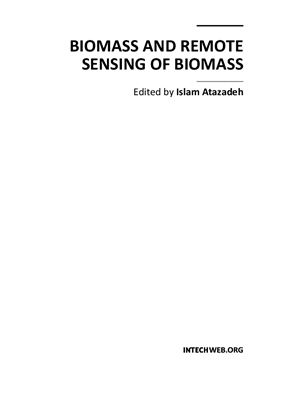InTech. 2011. 272 p.
Generally, the term biomass is used for all materials originating from photosynthesis. However, biomass can equally apply to animals. Conservation and management of biomass is very important. There are various ways and methods for biomass evaluation. One of these methods is remote sensing. Remote sensing provides information about biomass, but also about biodiversity and environmental factors estimation over a wide area. The great potential of remote sensing has received considerable attention over the last few decades in many different areas in biological sciences including nutrient status assessment, weed abundance, deforestation, glacial features in Arctic and Antarctic regions, depth sounding of coastal and ocean depths, and density mapping. The salient features of the book include: Several aspects of biomass study and survey Use of remote sensing for evaluation of biomass Evaluation of carbon storage in ecosystems Evaluation of primary productivity through case studies.
Contents
Preface
Part 1 Biomass
Biomass in Evolving World - Individual’s Point of View
Ecological Aspects of Biomass Removal in the Localities Damaged by Air-Pollution
Invasive Plant Species and Biomass Production in Savannas
Zooplankton Abundance, Biomass and Trophic State in Some Venezuelan Reservoirs
Estimation of Above-Ground Biomass of Wetlands
Soil Microbial Biomass Under Native Cerrado and Its Changes After the Pasture and Annual Crops Introduction
The Above-Ground Biomass Production and Distribution in White Willow Community During 11 Years of Primary Succession
Part 2 Remote Sensing of Biomass
Introduction to Remote Sensing of Biomass
Biomass of Fast-Growing Weeds in a Tropical Lake: An Assessment of the Extent and the Impact with Remote Sensing and GIS
Application of Artificial Neural Network (ANN) to Predict Soil Organic Matter Using Remote Sensing Data in Two Ecosystems
Part 3 Carbon Storage
A Comparative Study of Carbon Sequestration Potential in Aboveground Biomass in Primary Forest and Secondary Forest, Khao Yai National Park
Carbon Storage in Cold Temperate Ecosystems in Southe Patagonia, Argentina
Part 4 Primary Productivity
Long-Term UVR Effects Upon Phytoplankton Natural Communities of Patagonian Coastal Waters
In Situ Primary Production
Measurements as an Analytical Support to Remote Sensing - An Experimental Approach to Standardize the 14C Incorporation Technique
Generally, the term biomass is used for all materials originating from photosynthesis. However, biomass can equally apply to animals. Conservation and management of biomass is very important. There are various ways and methods for biomass evaluation. One of these methods is remote sensing. Remote sensing provides information about biomass, but also about biodiversity and environmental factors estimation over a wide area. The great potential of remote sensing has received considerable attention over the last few decades in many different areas in biological sciences including nutrient status assessment, weed abundance, deforestation, glacial features in Arctic and Antarctic regions, depth sounding of coastal and ocean depths, and density mapping. The salient features of the book include: Several aspects of biomass study and survey Use of remote sensing for evaluation of biomass Evaluation of carbon storage in ecosystems Evaluation of primary productivity through case studies.
Contents
Preface
Part 1 Biomass
Biomass in Evolving World - Individual’s Point of View
Ecological Aspects of Biomass Removal in the Localities Damaged by Air-Pollution
Invasive Plant Species and Biomass Production in Savannas
Zooplankton Abundance, Biomass and Trophic State in Some Venezuelan Reservoirs
Estimation of Above-Ground Biomass of Wetlands
Soil Microbial Biomass Under Native Cerrado and Its Changes After the Pasture and Annual Crops Introduction
The Above-Ground Biomass Production and Distribution in White Willow Community During 11 Years of Primary Succession
Part 2 Remote Sensing of Biomass
Introduction to Remote Sensing of Biomass
Biomass of Fast-Growing Weeds in a Tropical Lake: An Assessment of the Extent and the Impact with Remote Sensing and GIS
Application of Artificial Neural Network (ANN) to Predict Soil Organic Matter Using Remote Sensing Data in Two Ecosystems
Part 3 Carbon Storage
A Comparative Study of Carbon Sequestration Potential in Aboveground Biomass in Primary Forest and Secondary Forest, Khao Yai National Park
Carbon Storage in Cold Temperate Ecosystems in Southe Patagonia, Argentina
Part 4 Primary Productivity
Long-Term UVR Effects Upon Phytoplankton Natural Communities of Patagonian Coastal Waters
In Situ Primary Production
Measurements as an Analytical Support to Remote Sensing - An Experimental Approach to Standardize the 14C Incorporation Technique

